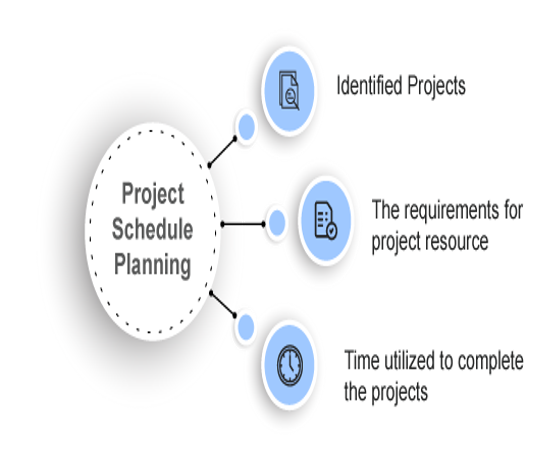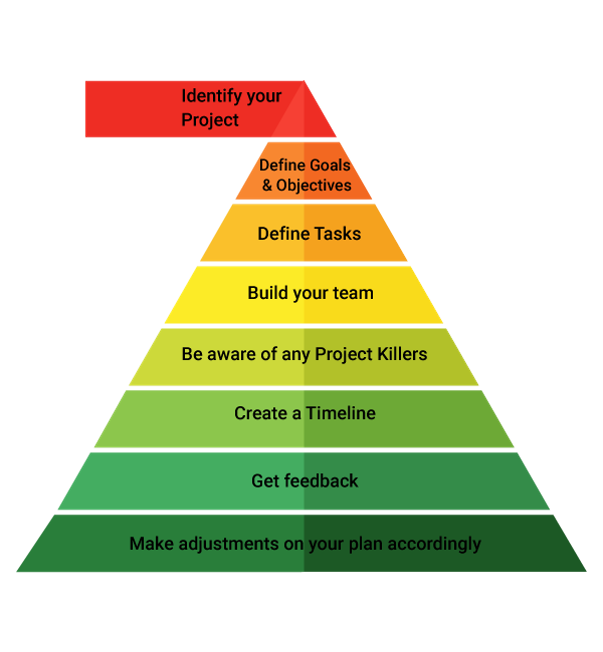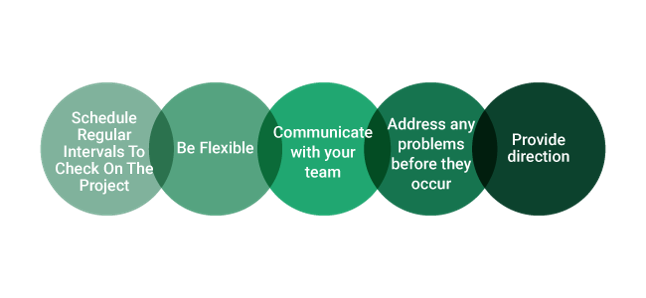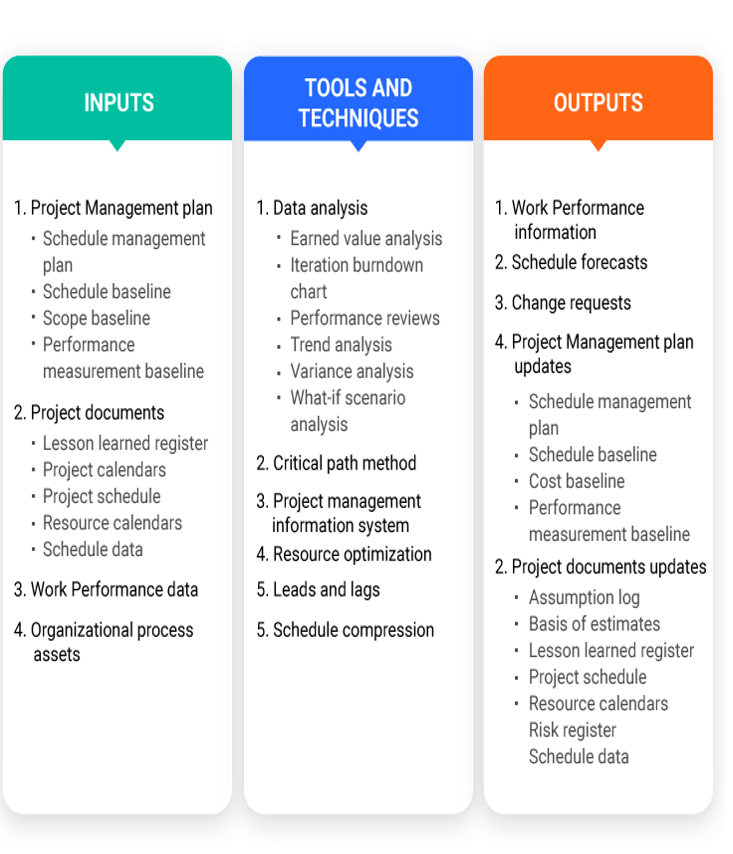
In every organization, projects are an essential method to build value. Running an organization with a lack of ideas and no proper schedules planned for projects would lead to failure. No matter what the size or scope of your project is, the project schedule articulates when each activity should be done, what is already done, and the sequence in which things need to be finished. In the present business environment, each organization ought to have the ability to manage and schedule with close-fitting budgets, resource scarcity, and the most recent technology patterns. This article discusses Project Schedule Management in detail and explains how you can plan, develop, maintain, and control the schedule of any project.
What is Schedule Management?
Schedule management is a procedure that requires the establishment of policies and documentation for maintaining, developing, managing, and controlling the schedules for time and resources for the completion of the project. The strategic benefit of the schedule management process is, that it will monitor and manage the schedule throughout the project.
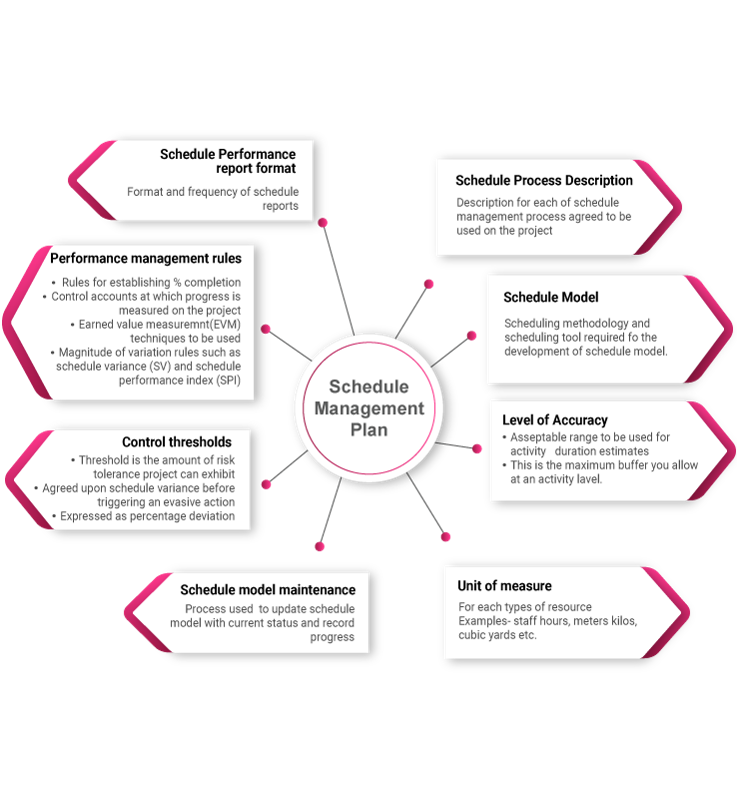
Project Schedule in Project Management? Explained!
A project Schedule is a technique that imparts what work should be performed, which resource of the organization will perform the work and the time spans in which that work should be performed. The project schedule ought to reflect the majority of the work related to handing over the task on time. Without a complete schedule, the project manager will be not able unable to communicate regarding costs and resources that are important to deliver the project.
Some software allows project managers to track project schedules, resources, budgets, and project-related assets in real time. The project schedule can be updated and viewed by colleagues related to the task and keeps everyone keeping everybody everyone well informed on the overall project status.
Project Schedule Planning in Project Management
The procedure of building policies, methodology, and project documentation gives direction and guidance on how the task timetable will be overseen all through the project. The intention of a project schedule is to organize and focused based on the advancement of the Schedule Management Plan.
The project plans should consider the following aspects,
The planning of the project schedule is an essential activity that incorporates identifying the project activities, sequencing them, and defining objectives for those activities alongside the project schedule management plan. As relevant as the project management scheduling ability is by all accounts, competency ought to obtain with significant experience.
Develop Project Schedule in Project Management!
Developing Project Schedule refers to planning the timing and sequence of project activities.
A project schedule assigns work to be done and indicates due dates to complete the tasks and deliverables. The project schedule portrays:
- Time (duration) estimates for all project tasks
- Start and finish dates for the tasks
- Names of staff resources assigned to complete the tasks
- Sequence of tasks
A noteworthy segment of a project schedule is a work breakdown structure (WBS). The project schedule is built to reflect the work breakdown structure.
Project scheduling is the key to ensuring the original project plan, and the final project outcome is at least close enough to call the project a success. Developing project schedules helps the project team to keep the necessary activities on track. PMBOK’s Schedule Management knowledge area explains the critical processes in developing a project schedule.
5 Steps That Help to Develop a Schedule in a Project
Project Management has always been fascinating in how things work and how to make things work better. Thus, a project schedule comes through the planning phase of any project. Below mentioned are the means that are expected to schedule a project:
1. Define Activities
Define activities lets project managers use the Work Breakdown Structure (WBS) and a deliverables diagram to establish and start the assignments that are essential to finish on time. Thus ensuring they are aware of what activities have to be included in the plan.
2. Sequence Activities
Sequence activities help to determine the relationship between the project activities. The ordering of the tasks and identification of dependencies (Finish to Start, Finish to Finish, Start to Start, Start to Finish) is the next step.
3. Do Estimates
The project team has the activities defined and the tasks in a breakdown structure; the following stage is to choose the time utilization to complete the project. To calculate a schedule, having an estimation of what to do, how to do it, and the essential part of the equation is to what extent should a project take to finish.
4. Determine Dependencies
Projects aren’t simple always. On a regular basis, a project can’t be started until the one in the process is finished. These are called task dependencies. Consequently, your schedule will need to reflect on these connected projects. As project supervisors, you can likewise pursue a methodology by monitoring your schedule to suit these related projects.
5. Assign Resources
The last step is to Assign Resources to finish your planned schedule. It picks what resources you should complete the given assignments on time. As a project management team, you need to have the right resources and their time ought to be considered to plan the assignments.
When you have intended to formulate the schedule for a project, get feedback from your manager and roll out the essential changes that have to be finished. You’ll need to estimate the project plan before you move on to executing the plan. Once the project is in progress, it’ll help you compare the planned versus actual dates. Consider the task’s goals that assist you to set up a schedule once you complete the process.
How to Develop a Project Schedule?
| What To Do? | How To Do It? |
| Determine the tasks to be placed in the schedule | Refer to the tasks identified in the work breakdown structure. |
| Determine the relationships between the tasks | Identify tasks that must be completed before other tasks can begin. Identify tasks that can be done while other tasks are being performed.
|
| Assign each task to a specific staff | This establishes ownership of the task.
Assigning the right person to the right task is one of the most critical factors in a project’s ultimate success. |
| Estimate the amount of effort required for each task | Work with individual team members or others who have experience with this type of project.
Base the estimate on an assumed level of skill. Document assumptions used in estimating. |
| Consider the other variables that go into building the schedule | Example variables to consider:
|
| Build a time reserve into the schedule for contingencies and unforeseen events | A contingency is a specific provision for unforeseeable elements that could cause schedule delay.
How much time contingency to allow can depend on:
A good rule of thumb for schedule contingency is 20%, but a project can include more or less based on the factors above. |
| Identify the project’s critical path | The critical path is a project management technique that analyzes what activities have the least amount of scheduling flexibility (i.e., are the most important) and then predicts project duration based on the activities that fall along the “critical path.”
Activities that lie along the critical path cannot be delayed without delaying the finish time for the entire project. If the critical path exceeds a required deadline, review methods to shorten the critical path. |
| Check to see if the staff is over-allocated | If the staff is over-allocated, figure out a way to level the team so they are assigned the right amount of work.
Possible actions
Caution: There is an overhead cost for bringing new staff up to speed. Not all team is truly interchangeable. The skill level of the new person may affect the time to complete and the quality of the work. Contract staff may need more oversight. |
| Repeat steps 3 and 5-8 until a baseline is established. | Developing the project schedule is an iterative process. |
| Place the schedule information in a Gantt chart | Place the tasks, milestones, relationships, staff assigned, duration, and work estimates in a Gantt chart to show the detailed timing of the project.
A Gantt chart graphically represents a project by showing each task as a horizontal bar whose length is the time needed to complete the task. Various project management tools can generate Gantt charts. Other formats can be used to display the schedule information based on the needs and preferences of your customer. |
Maintain the Project Schedule in Project Management
Amid the essential project management abilities, booking can influence, either decidedly or unfavorably, the most territories inside a task. Inadequate project schedules can create hindrances to your project schedule management thus creating an interruption for individuals and production equipment leading to project failures.
Here are a few techniques that can help you maintain your entire project schedule:
Planning About the Project
A successful project is all about planning. A well-designed project plan will save time, cash, and a considerable measure of cerebral pains once the undertaking is dispatched. To begin with, creating a project plan, should focus on the following components:
Once the project plan is ready, present it to all the board members to utilize it as the roadmap during the project.
Maintain the Project on Track
A clear and well-defined project plan can help guide a project team throughout the project. A constant review, revising, and monitoring of the project is also necessary from the start until the end of the project.
Utilize Project Management Software
Regardless of how detailed the project plan is and how prepared you are, project managers face a lot of challenges. Gratefully, technology has made overseeing everything from online life records to client connections more powerful and advantageous. Project managers likewise prefer to get access to software that has made their lives simpler.
Time Management
For every project management team, it’s always an advantage to be skilled in effectively managing time in the workplace. While there are varieties of methods that a project management team could use to deal with the opportunity, here are a few of the best techniques to follow:
-
- Delegate Tasks
- Prioritize your tasks
- Run more effective meetings
- Learn to say ‘no.’
- Write tomorrow’s task today
Celebrate the success
Once the project completes by implementing the right strategies, the ultimate opportunity for the project management team is to celebrate. A well-known approach to observing is by going out to have a team dinner or having a few celebratory drinks. Rewarding the team with certification or thanking the team in person is also a good sign.
“Control Project Schedule” in Project Management
Control of a Schedule in Project Management signifies the approach to monitoring the status of the project, and consequently, updating and managing the project changes to the scheduled baseline to accomplish the goal.
This procedure helps to decrease the threat of delivery slippage when handled well. Besides monitoring the status, the schedule control process updates projects and manages the change in the schedule so that project managers can achieve the goal.
Know the Principles of Control Schedule Process
-
The developments not only should be responded to but instead, be controlled proactively. The project managers need to act quickly before the changes impact the complete schedule.
-
The control schedule process deals with the abilities of the stakeholders approaching them with guidance to work that the project managers have to accomplish according to the type and duration of the work.
-
Knowing the actual performance of the schedule is essential. The control schedule process permits project managers to adopt the status of the project schedule and validate the required changes and manage it.
The below-given figure depicts the inputs, tools, techniques, and outputs of this process.
Control the Project Schedule: Techniques
- By utilizing Earned Value Management (EVM) the schedule variance and schedule performance index employ to survey the scope of schedule changes.
- In schedule control, it is essential to decide if the schedule variation needs corrective action. For instance, if there is an interruption in the project that leads to a negative impact on the schedule plan and thus requires immediate action.
- Utilize the critical chain scheduling method; you can compare the amount of defense needed and the remaining security to regulate the schedule status.
- The utilization of measurements of Schedule performance to evaluate the amount of variation to the original schedule baseline. The aggregate float variance is likewise a vital module to assess project time performance.
- Essential aspects of project schedule control incorporate deciding the reason and level of change with respect to the schedule baseline and choosing whether it requires corrective or preventive action.
An Agile Approach to Control Schedule
Agile Project Management methodologies have been growing in adoption. Several organizations are now engaging their projects with a combination of traditional project management and Agile Project Management tools.
While agile techniques provide many useful progress indicators, Control Schedule is concerned about:
-
Organize demonstrations for correcting the process to improvise when required.
-
Re-prioritizing the rest of the work design.
-
Regulating the rate where the projects are delivered, approved, and acknowledged in the given time per emphasis.
-
Managing genuine changes as they happen.
Conclusion
By not utilizing the right procedure for the project schedule things can go wrong with any given project. And this is the time that you think of something to be simplified and track the progress of your project as needed. Give yourself a chance to enhance your Project Management skills with Best Online PMP Training, and excel in your career.
Know more about Project Management best practices through Invensis Learning’s Project Management certification training on PMP Training Program, CAPM Certification Training, Prince2 Certification Online, Project Management Fundamentals, etc.



